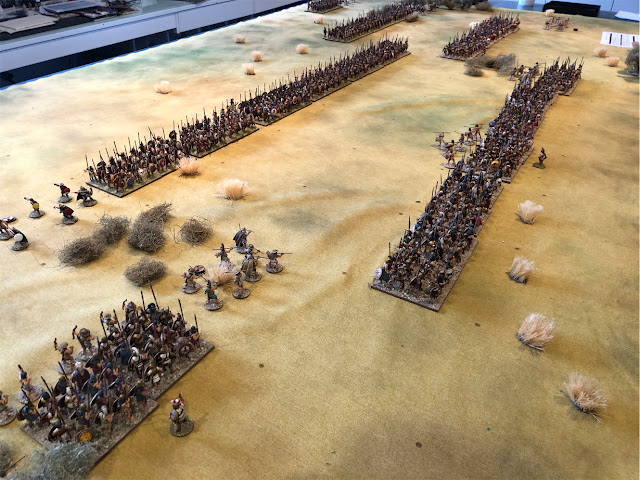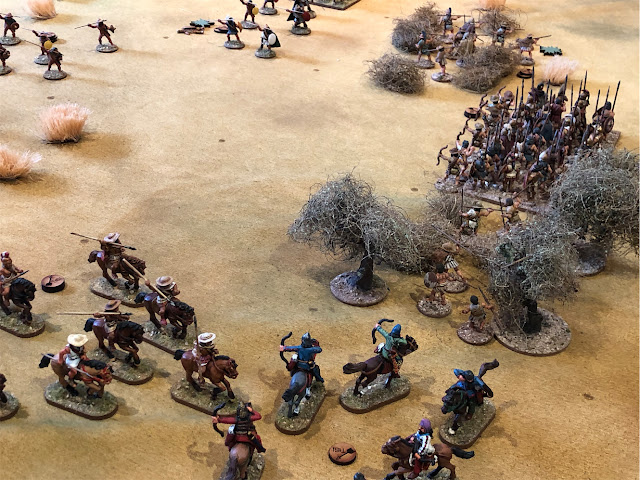Last time I finished off the new table mat for playing To the Strongest!...time to give it a run! We're off to Ancient Greece where the forces of imperial Athens once more spread their tentacles north toward the recalcitrant Chalcidian League in the opening stages of the Great Peloponnesian War.
Protasis
429, 3rd Year/SummerIn the third summer of the Archidamian War, Athens continued to prosecute its siege of Potidaea. This expensive operation was depleting the Athenian treasury and the policy of sitting behind Athens' walls and using their fleet to conduct naval amphibious operations was not paying the handsome strategic dividends hoped for. The continued resistance of the Chalcidicean coastal town of Potidaea was a particular problem.
Nevertheless, continued operations in the north were still prosecuted. In our story we follow one such mission to subjugate the Dorian leaning town of Stolos and Olynthus. No friend of Athens, both Dorian leaning towns were rallying points for anti-Athenian forces in region. Therefore a plan was hatched to dispatch a naval force from Athens, make an amphibious landing at Therma in the north west of the Chalcidice peninsular, and march east then south to clear the northern outposts of these troublesome settlements. This would, it was hoped, with one swift stroke remove the thorn in the side to the ongoing Athenian operations further south at Potidaea.
As with all things in the greek world at this time, keeping such plans a secret was difficult if not impossible. Word reached Olynthus. An immediate call to muster was raised and an Olynthian force marched north, gathering allies in Stolos as well as (promised) Thessalian cavalry forces, henceforth marching west to block the approach of the Athenian force along the banks of the Chita river.
With the Athenians marching east, the Olythians west, the stage was set as the two sides clashed to decide the immediate fate of northern Chalcidice and latterly Potidaea.
The subordinate (allied) Stolosian leader, Margos.
Athenian cavalry ride in front of the line to take up position.
Set Up
The game we played was a straight up ’points clash’ of To the Strongest, our rules of choice for large actions. The scenario was an open field encounter with the terrain setup using the 'Lay of the Land' section of the rules. This enabled both players a degree of choice as to the type of terrain to be placed. Each side randomly chose a stratagem with the Athenian player out-scouting the Olynthians, hence designated the 'active' player. Deployment was carried out with the outscouted Olynthians deploying first.
Forces
Athenian - the Athenian forces, commanded by Phalakos, with two strategoi Akragas and Tolmides the Euboean each commanding a contingent, which included the usual complement of hoplite infantry along with mercenary peltasts (no doubt arranged before the expedition got under way), light infantry javelinmen along with some cavalry including some Scythian horse archers. The Euboean troops were picked up whilst sailing north after harbouring on the island of Scyros. It represented an a-typical expeditionary Athenian force supported by local allies that was properly proportioned for an open field encounter. Victory Medals = 16
Olynthians - the Olynthian forces led by Conon, a man of Thracian origin, chose a similar army most typical of the Greek world. It included a contingent of two hastily organised (raw) Stolosian hoplite units led by the strategos Margos along with the bulk of the men being ‘garden variety’ Panhellenic hoplite infantry plus the veteran epilektoi men of Olynthus. Victory Medals = 14
Supporting the main force were several units of rough terrain troops in form of a few units of light infantry javelinmen and Thracian peltasts and a small contingent of Thessalian light and medium horse, able to fight in their famed Rhomboid formation. Larger hoped for allied Thessalian cavalry and light infantry from Thrace did not appear in the numbers that were expected. These support troops formed the numerically lesser part of the army.
Note - Neither player new the composition of the other sides force. Force size was 160 point armies, quite large by TtS standards for a ‘pick-up game’, using the TtS army lists. As it transpired, the Athenian player expected a cavalry heavy Olynthian force but instead faced off against a hoplite heavy opponent. In addition, for variation, we had the Athenian commanded by 3 generals and the Olynthians only two. We were interested to see how the impact of 3 vs commands had on play and the management of a hoplite phalanx.
Marking hits - in the pics you will see units with a (hit) marker that is either green (1 hit) or yellow (two hits). The 'dead hoplite' figure records disorder.
The armies arrayed for battle. Athenians to the left, their right flank Athenian hoplites, their centre-left Euboeans. Olynthians to the right, left wing Stolosians.
Table is 16 x 8 boxes (11'x5'). Each box is 7.5”.
Looking from the left rear of the Olynthian line. Left wing peltasts and psiloi covering the weaker Stolosian flank. The cramped terrain layout resulted in the Stolosian hoplites deployed facing rough ground to their front - not ideal ground for hoplites.
The Athenian battleline with light troops up front.
Stolosian hoplites.
Athenian allied Scythian horse archers, bought and paid for from the Athenian treasury….nothing ‘greek’ about these fellows. They provided left flank protection to the Athenian light troops.
Behind the horse archers were the Greek cavalry contingent from Athens.
Disciplined line with the left flank Stolosian forces under Margos (left of pic).
Support infantry for the Olynthians. Thracian peltasts and tribal psiloi mixed in.
Thessalian medium cavalry
Epitasis - conflict
With both armies arrayed for battle the Athenians moved off. The men of Athens on the right advance forward, no doubt this being the position of their best men, with their allied Euboean (raw) hoplites to their left. Similarly, the Olynthians moved up quickly on their right whilst pushing forward their left wing light troops into the woods (near pic).
(Near pic) Athenians advance forward opposing the Stolosian hoplites.
Close up of the Olynthian phalanx pressing forward and thereby creating a gap in the line. Euboean hoplites to their front.
On the Olynthian right the Thessalian light horse press forward to close the range with the Scythians.
A wider shot from behind the Athenian left flank.
The Athenian main battle line (Euboeans), has moved forward so as not to isolate their right wing advance whilst the left flank, Tolmides in command (lower left), moves up, with the light infantry attempting to seize some advantageous rough ground to their front.
Light infantry attack!
The Athenian commander, Phalakos, ordered forward his light troops, sending a body of psiloi javelinmen to harass the Olynthian hoplites. This was directly opposite Conan and his veteran epilektoi.
With a wry smile The Athenian commander ‘played’ his strategem, unleashing an assassin after the Olynthian commander Conon. With this shabby trick played, Conan had to survive four attempts on his life! With the quick-wits of a panther, the veteran commander eluded the assassin’s arrows!...they don't call him Conon the barbarian for nothing 😬
The lone psiloi ‘trireme rowers’ unit scores first blood!
On the right, the Olynthian 'lights' supported by Thessalian cavalry advance.
With the battle lines pressing forward it was the Athenians who struck first with their heavy infantry. Charging Margos' men they were surprised the Stolosian fought back with such vigour. They received the Athenian charge and fought back inflicting a loss on their opposing number. Akragas, arms crossed, was not impressed!
Stolosian light troops and mercenary peltasts press forward into the rough.
Wide angle shot from Olynthian left flank.
With the initial clash on the Olynthian left wing being more promising than hoped for the extreme left of the line of hoplites moves into the rough ground to their front in an attempt to pass through and form up on the other side.
Meanwhile, Conon, incensed at the dubious attempt on his life, orders his veterans forward only to find the remainder of his batteline stall, leaving him somewhat isolated in the Metaichmion ie no man's land.
…possibly due to the presence of enemy in the rough ground the phalanx stalled. Nevertheless, these Athenian peltasts unload some effective javelin fire from said ground at their opposite number who unleash some pain of their own with some accurate arrow fire...one hit each!
Not wanting to endure long range bow fire the Thessalian light cavalry launch themselves at the Scythians.
The Olynthian battleline in some disarray. The impetuous move forward by Conon and his veterans has disjointed the solid Olynthian phalanx.
The cavalry skirmish continues between the horsemen of the north.
Meanwhile the press of shields continues on the Athenian right flank.
At the point of a spear, Tolmides is killed with a lethal blow and his hoplites continue taking yet more punishment from the hard men of Stolos.
Stolosians rejoice! With the enemy commander slain and their hoplites rocked back on their heels, Margos is well pleased with his men's efforts.
In the next post we will pick up the action as the contest heats up and finish our battle report - will the Olynthians hold on, defeating the Athenians or will the press forward to victory and On To Potidaea?
...tune in to find out.




































No comments:
Post a Comment